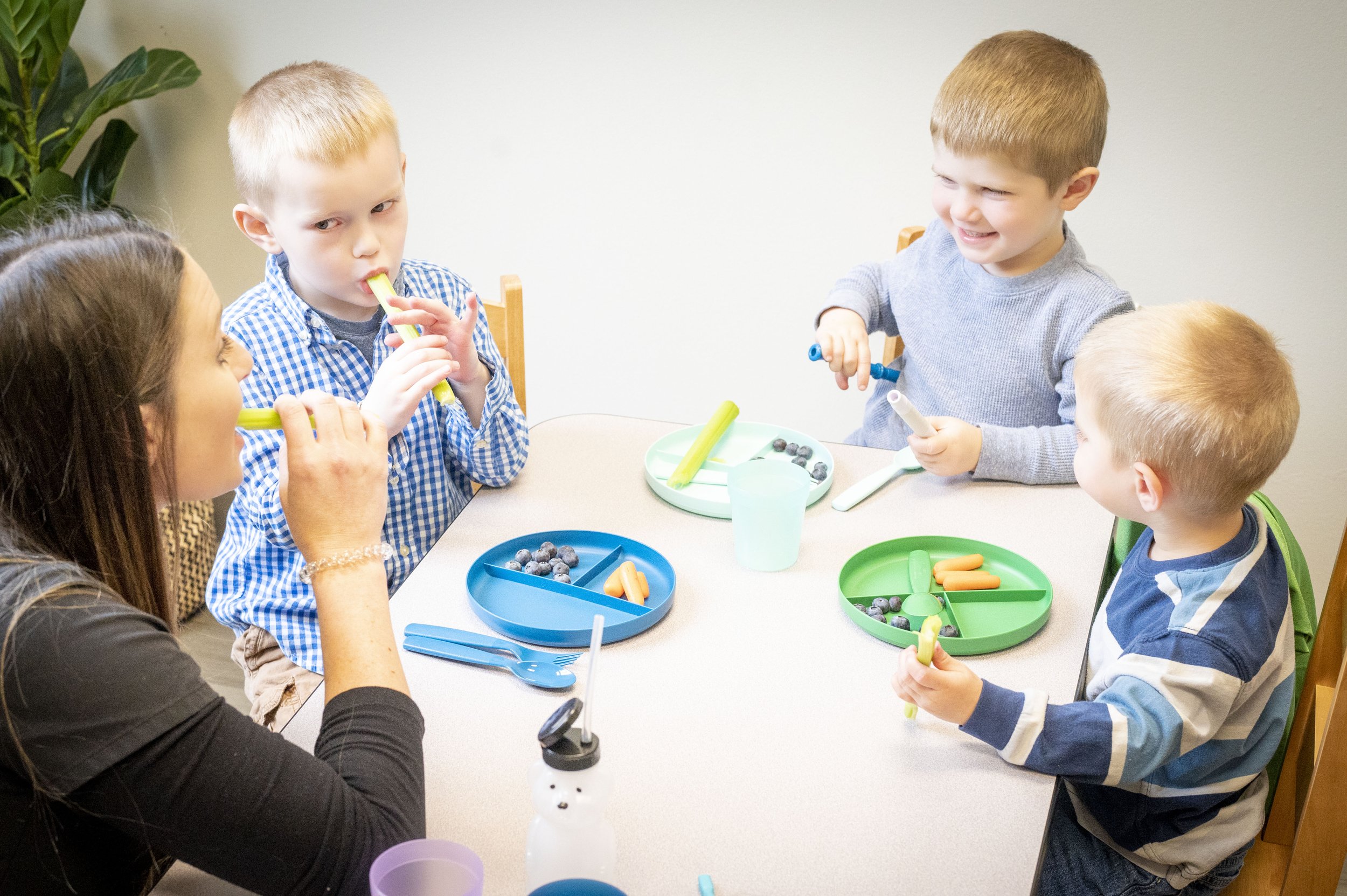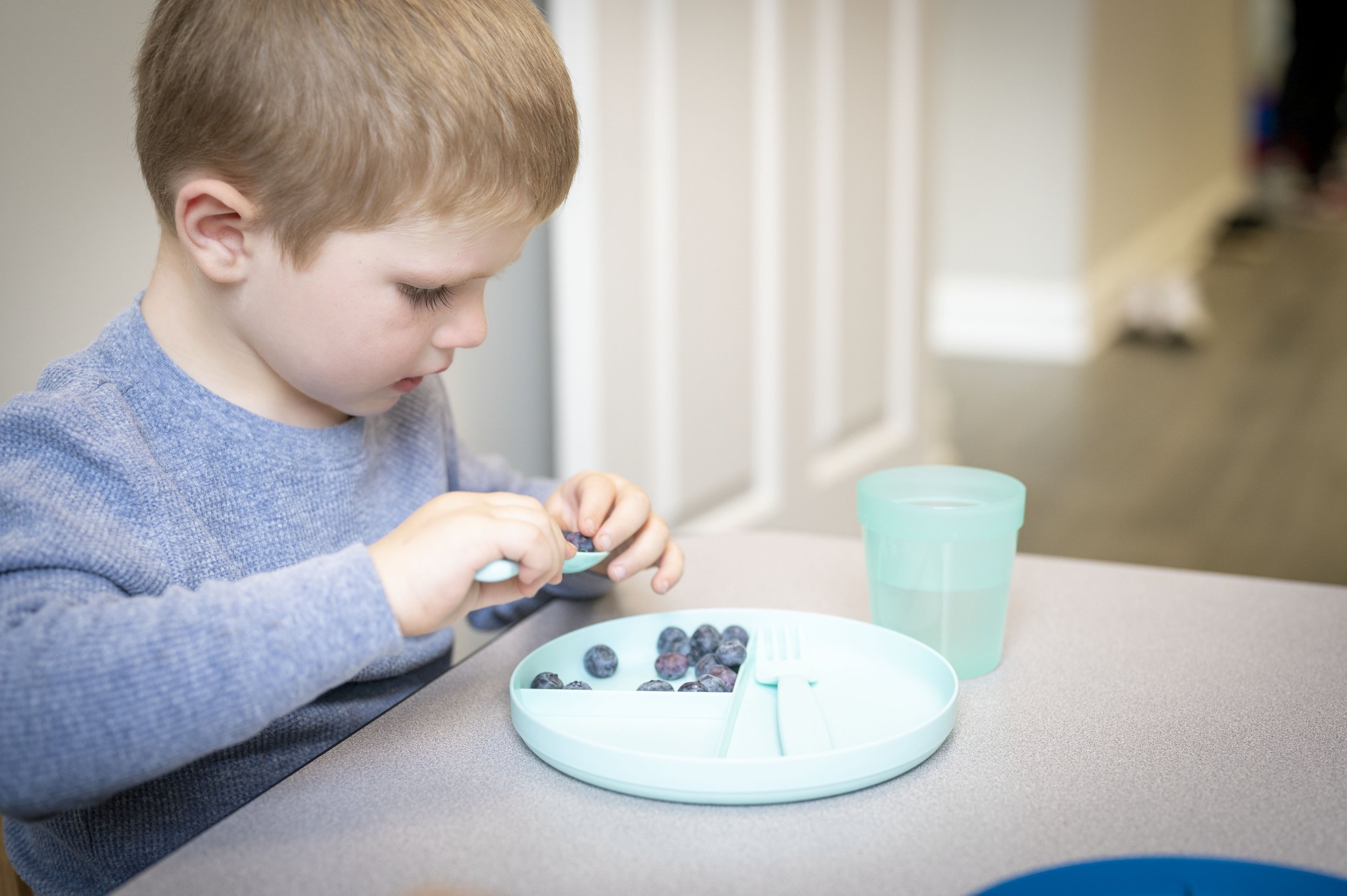Pediatric Feeding Therapy
Our feeding therapy is provided in a collaborative team approach, made up of occupational therapist, speech therapists, myofunctional therapists, and a dietitian. We utilize a team approach to provide the most comprehensive and complete care to treat the underlying causes and support optimal function and independence. In addition to our in-house team, we collaborate with local providers to make sure all necessary structural and functional aspects of eating and swallowing are appropriately addressed. This collaborative team approach supports the best outcomes for our clients and their families.
Let our feeding therapy team support your child by helping to discover underlying causes of their feeding behaviors, develop a professional multidisciplinary team, and provide intervention to help them reach their maximum function and independence.
Picky Eating
Feeding therapy can be very beneficial for children with and without a diagnosis or condition. Though many children with diagnoses show signs and symptoms of feeding disorders, many neurotypical children also demonstrate feeding disorders and picky eating which interfere with their ability to participate in age-appropriate mealtime routines and get adequate nutrition from whole foods. Picky eating is one of the most common conditions reported to pediatricians, with up to 50% of children being reported as picky eaters with vegetables being the most commonly omitted food group (Mascola, Bryson, & Agras, 2010).
Nutrition plays a pivotal role in brain development and cognition, specifically in the early years of life as brain development is faster during this period which makes dietary deficiencies more impactful (Nyaradi, et al, 2013). Studies show that picky eating in children is associated with constipation, poor physical activity, fear of unfamiliar places, and high occurrence of medical illness compared to same aged typical eaters (Chao, 2018). Additionally, a child that is a picky eater can impact the whole family, causing increased stress and anxiety around mealtimes and leaving parents and caregivers frustrated, confused, and upset. Picky eating in early childhood and adolescent years is shown to have significant negative impacts on growth, development, nutritional status, physical activity, and health status overall (Chao, 2018).
Common conditions/diagnoses/disorders that we help in feeding therapy:
AFRID
Picky Eating
Food Aversion/Texture Aversion
Dysphagia
Pediatric Feeding Disorder
Oral Motor Dysfunction
Tube Dependence
Choking, gagging, vomiting during eating
Aspiration
Bottle Feeding
Low Muscle Tone
Sensory Dysfunction
Gastroesophageal Reflux Disease (GERD)
Behavioral management/modification during mealtime
Difficulties and deficits related to ASD, Cerebral Palsy, Down Syndrome
Do you think your child might be a picky eater?
Wondering if feeding therapy could help? Download our parent screening tool here.
Feeding Therapy Groups
-
In addition to one-on-one treatment options, we offer feeding peer groups. Research supports the positive impact of feeding therapy in group settings with similar aged peers. Using evidence-based interventions, our highly skilled therapy team creates meaningful and functional group activities to facilitate generalization of skills from individual treatment to a wide variety of settings (home, school, community). Group sessions are typically recommended following some individual treatment and provide good opportunities for children to practice their new skills in a social setting. This also can present additional challenges of mealtimes and allows our therapy team to be present to support the child in mastering all areas of mealtime. Parent training and education is always a part of feeding therapy and greatly supports the success of the child.
Feeding Groups are a great example of one of our specialty services that supports our choice for remaining as out of network providers. Unfortunately, most insurance companies will not approve co-treatment provided by multiple therapy disciplines or group therapy sessions, which would limit our ability to provide the most comprehensive care to our clients.
Developmental Milestones
0-3 months
reacts to loud sounds
cry differs based on needs
smiles at parent/caregiver
turns head towards sounds
makes eye contact
coos and smiles
pushes up on arms while on tummy
opens fists
tolerates tummy time for short periods
brings hands to mouth
visually tracks toys side to side while lying on back
able to keep head at midline/centered while lying on back
enjoys different types of movement
can be calmed with rocking, soothing noises, and touching
happy if not hungry or sleepy
latches during feeding on nipple or bottle
sucks and swallows well with minimal loss from side of mouth
10- 12 months:
Claps hands
Purposeful release of objects
Able to hold/self-feed with bottle in upright position
Walks with one handheld assist
Pulls to stand and cruises
Stands without support
Takes multiple steps independently
Moves in and out of different positions to explore
Crawls towards desired toy
Self feeds with fingers
Able to drink from open cup
Starting to explore using utensils
Increased variety of smells and tastes that are preferred
Enjoys games like pat-a-cake, peek-a-boo
Uses “mama” and “dada” meaningfully
Turns to sounds
Points to objects of interest
Responds to simple command ("come here")
Uses gestures (waving, reaching out with arms)
Uses one- two simple words
Responds to “no”
Turns head to name
2- 3 years old
Snips with scissors
Able to imitate lines or circles
Balance on one foot for 5-10 seconds
Catch a medium ball
Walks with heel toe pattern, does not toe walk
Coordinates hands and fingers
Appropriate strength and endurance to play with peers
Able to use hands together for play (swinging a bat, opening a container)
By 3 able to snip with scissors, while moving forward across paper
Enjoys bath time
Tolerates diaper changes without crying
Tolerates schedule/routine changes
Able to self soothe when upset
Acknowledges and responds to injury/pain
Able to maintain eye contact with others and demonstrate interest and awareness during interactions
Has a word for almost everything
Talks and requests with 2-3 word phrases
Uses plurals
Uses “in” and “on”
Understands “yours” and “mine”
Understands “why” questions
Most speech is understood by family and friends (36 months)
Able to eat the same foods as their family (by 36 months)
Self feeds with utensils well
Able to wipe face/mouth during mealtime
Tolerates mealtime at table with family/peers for appropriate duration
4-6 months
Opens mouth to spoon
Shows interest in food
Begins eating smooth, pureed foods
notices toys with sounds
babbles (ex: da,da,da)
laughs
reacts to sudden noises
maintains eye contact with familiar person during play
supports self with hands in sitting
rolls tummy to back, back to tummy
accepts all weight in legs when supported in standing
plays with feet with both hands while lying on back
transfers toys one hand to the other when lying on back
explores toys with both hands
raises hands to be picked up
isn’t upset by common everyday sounds
can be calmed
able to prop on elbows and pick up head during tummy time
13- 18 months:
Pointing with index finger
Able to put objects into containers
Able to kick a ball
Walks independently with minimal falls
Stacks two blocks
Able to squat to pick up a toy or object
Helps with dressing
Sleep schedule is regular
Uses 5-10 words
Puts gestures and sounds together
Follows simple directions regularly
Interest in pictures
Able to identify 1-2 body parts if named
Understand 50 words
Points to familiar objects and people in picutres
Responds to yes/no questions with head shake
Holds and drinks from an open cup
Increased variety of foods eaten
Increased variety of food textures eaten
Able to eat coarsely chopped foods
4- 6 years old
Answers who? what? why? where? questions
Able to talk about activities from their day
Uses 4+ word sentences
Enjoys a variety of age appropriate toys
Able to locate items that are pointed at
Doesn’t put non food items in mouth
Demonstrates safety awareness
Uses appropriate force during play with pets and peers and when using and holding objects
Maintains balance on uneven surfaces
Able to maintain attention and play with one toy or theme for 15 minutes
Able to cut paper in half, cut circle within ½” of boundary line, cut square within ¼ of boundary line (5 years)
Able to imitate/draw cross, square (4 years), diagonal lines, and triangle (5 years)
7- 9 months:
Independent sitting
Reaches for toys in sitting without falling
Turns head to track while sitting
Uses finger and thumb to pick up small objects
Imitates others in simple play
Crawls on hands and knees with alternating movement
Turns several pages in board book
Enjoys musical toys
Moves to explore surroundings when on the ground
Maintains head forward when being pulled from lying to sitting
Investigates toys and surrounds (shape, size, textures)
Able to drink from straw
Holds and drinks bottle when seated in highchair
Is full for longer periods after eating
Demonstrates strong reactions to smells and tastes that are new
Begins to progress through more textures (lumpy, mashed)
Variety of sounds and syllables used in babbling increases
Recognizes sound of name
Interested in play with others
Uses simple gestures (shaking head for “no”)
Imitates sounds
Able to follow a few simple routine commands when paired with a gesture
19-24 months:
Self feeds with spoon
Completes simple shape sorter toy
Walks and runs well
Explores variety of environments
Enjoys swinging and movement play
Minimal mouthing of toys
Can participate in small group with peers
Enjoys playing with new toys
Likes to sit and listen or look at a book
Maintains balance to throw and catch ball
Minimal loss of food during chewing and swallowing
Scoops with spoon, Stabs with fork, (not efficient until after 24 months)
Eats a wide variety of foods
Uses at least 50 words
Identifies 3-5 body parts
Imitates new words regularly
Uses simple pronouns
Begins to use two word phrases and questions ("where dog?" "go bed")
Follows 2-step direction for familiar task (“Pick up book and bring it to me”)
*Folio & Fewell (2000). Peabody Developmental Motor Scales
*Parham,D. et al (2007). Sensory Processing Measure
*Pathways.org (2021) Milestones & Abilities




